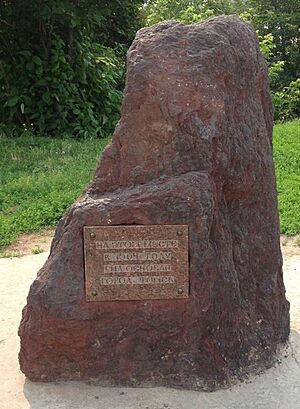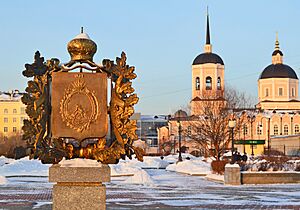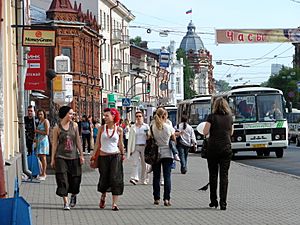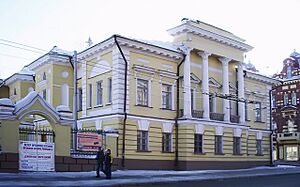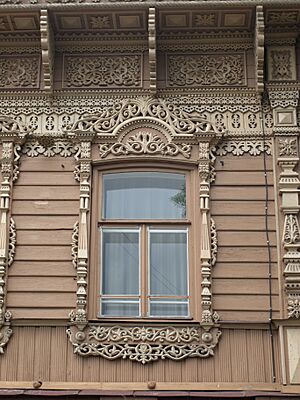Tomsk facts for kids
Quick facts for kids Tomsk (English)Томск (Russian) |
|
|---|---|
| - City - City Under Oblast Jurisdiction |
|
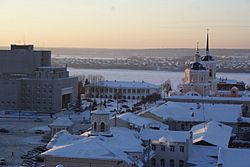 View of Tomsk |
|
| City Day | June 7 |
| Administrative status | |
| Country | Russia |
| Federal subject | Tomsk Oblast |
| Administratively subordinated to | Tomsk City Under Oblast Jurisdiction |
| Municipal status | |
| Urban okrug | Tomsk Urban Okrug |
| Mayor | Ivan Klyayn |
| Representative body | Duma |
| Statistics | |
| Area | 294.6 km2 (113.7 sq mi) |
| Population (2010 Census, preliminary) |
524,669 inhabitants |
| - Rank in 2010 | 32nd |
| Density | 1,781/km2 (4,613/sq mi) |
| Time zone | OMST (UTC+07:00) |
| Founded | 1604 |
| Postal code(s) | 634xxx |
| Dialing code(s) | +7 3822 |
| Official website: http://www.admin.tomsk.ru/ | |
Tomsk (Russian: Томск, IPA: [tomsk]) is a big city in Russia. It is the main city of Tomsk Oblast and sits on the Tom River. About 556,000 people live there.
Tomsk was founded in 1604, making it one of the oldest cities in Siberia. It is famous for its six universities, which teach over 100,000 students. One of these is Tomsk State University, the oldest university in all of Siberia.
Contents
- History of Tomsk: A Journey Through Time
- City Structure and Divisions
- Climate and Weather in Tomsk
- Economy and Energy in Tomsk
- Education: Tomsk's Universities and Research Centers
- Transportation: Getting Around Tomsk
- Culture and Fun in Tomsk
- Famous People from Tomsk
- Tomsk's Global Connections
- Images for kids
- See also
History of Tomsk: A Journey Through Time
Tomsk started in 1604 because of a special order from Tsar Boris Godunov. A local leader named Toian, from the Siberian Tatars, asked the Tsar for help. He needed protection from another group called the Kyrgyz.
The Tsar sent 200 Cossacks, who were skilled soldiers. They built a strong fort on the bank of the Tom River. This fort became the start of the city of Tomsk. Toian gave the land for the fort to the Tsar.
How Tomsk Grew and Changed
In 1804, the Russian government chose Tomsk to be the main city of a new large area called Tomsk Governorate. This area included places where cities like Novosibirsk and Krasnoyarsk are today. This new importance helped Tomsk grow very quickly.
The discovery of gold in 1830 brought even more growth to Tomsk. However, in the 1890s, a major railway, the Trans-Siberian Railway, was built. It went around Tomsk, passing through a smaller village instead. This caused growth to shift away from Tomsk. Over time, Novosibirsk became more important than Tomsk.
Tomsk: A City of Learning
In the mid-1800s, many people who were sent away from their homes lived in Tomsk. But soon, the city changed its focus. It became a major center for education in Siberia. This happened when Tomsk State University was founded in 1880. Later, Tomsk Polytechnic University opened in 1896.
By the time of World War II, about one in every twelve people in Tomsk was a student. Because of this, the city earned the nickname "Siberian Athens".
Tomsk During Difficult Times
After the October Revolution in 1917, Tomsk became a center for the White movement. This group was against the new Soviet government. After the Red Army won in the 1920s, Tomsk became part of larger regions.
During World War II, many factories from war zones moved to Siberian cities like Tomsk. This made the city grow a lot. Because of this growth, a new region called Tomsk Oblast was created, with Tomsk as its main city.
During the Cold War, Tomsk was a "closed city". This meant that outsiders, especially foreigners, were not allowed to visit. In 1949, a secret city called "Tomsk-7" was built nearby. It was home to a nuclear power plant. Tomsk-7 later became a separate city called Seversk in 1992.
City Structure and Divisions
Tomsk is the main city for its region, Tomsk Oblast. It is also the administrative center for Tomsky District. Tomsk itself is divided into four main areas: Kirovsky, Leninsky, Oktyabrsky, and Sovetsky.
Climate and Weather in Tomsk
Tomsk has a humid continental climate. This means it has warm summers and very cold, long winters. The average temperature for the whole year is about 1.2 degrees Celsius.
Winters are very harsh. The coldest temperature ever recorded was -55 degrees Celsius in January 1931. However, the average temperature in January is usually between -21 and -13 degrees Celsius. Summers are much warmer, with an average temperature of 18.8 degrees Celsius in July. The city gets about 587 millimeters of rain each year. In 2006, Tomsk had very strong winds, like a hurricane, which knocked down trees and damaged buildings.
| Climate data for Tomsk (1991–2020, extremes 1837–present) | |||||||||||||
|---|---|---|---|---|---|---|---|---|---|---|---|---|---|
| Month | Jan | Feb | Mar | Apr | May | Jun | Jul | Aug | Sep | Oct | Nov | Dec | Year |
| Record high °C (°F) | 3.7 (38.7) |
7.5 (45.5) |
17.7 (63.9) |
30.1 (86.2) |
34.4 (93.9) |
35.6 (96.1) |
35.6 (96.1) |
33.8 (92.8) |
31.7 (89.1) |
25.1 (77.2) |
11.6 (52.9) |
6.5 (43.7) |
35.6 (96.1) |
| Mean daily maximum °C (°F) | −13.4 (7.9) |
−9 (16) |
−0.4 (31.3) |
8.7 (47.7) |
17.5 (63.5) |
23.0 (73.4) |
25.0 (77.0) |
21.9 (71.4) |
14.7 (58.5) |
6.3 (43.3) |
−4.8 (23.4) |
−11.1 (12.0) |
6.5 (43.7) |
| Daily mean °C (°F) | −17.5 (0.5) |
−14.2 (6.4) |
−6.3 (20.7) |
2.6 (36.7) |
10.4 (50.7) |
16.5 (61.7) |
18.8 (65.8) |
15.9 (60.6) |
9.2 (48.6) |
2.0 (35.6) |
−8.2 (17.2) |
−14.9 (5.2) |
1.2 (34.2) |
| Mean daily minimum °C (°F) | −21.2 (−6.2) |
−18.4 (−1.1) |
−11.2 (11.8) |
−2.2 (28.0) |
4.9 (40.8) |
11.2 (52.2) |
13.8 (56.8) |
11.3 (52.3) |
5.2 (41.4) |
−1.1 (30.0) |
−11.3 (11.7) |
−18.5 (−1.3) |
−3.1 (26.4) |
| Record low °C (°F) | −55 (−67) |
−51.3 (−60.3) |
−42.4 (−44.3) |
−31.1 (−24.0) |
−17.5 (0.5) |
−3.5 (25.7) |
1.5 (34.7) |
−1.6 (29.1) |
−8.1 (17.4) |
−29.1 (−20.4) |
−48.3 (−54.9) |
−50 (−58) |
−55 (−67) |
| Average precipitation mm (inches) | 36 (1.4) |
26 (1.0) |
29 (1.1) |
35 (1.4) |
50 (2.0) |
60 (2.4) |
72 (2.8) |
68 (2.7) |
52 (2.0) |
53 (2.1) |
55 (2.2) |
51 (2.0) |
587 (23.1) |
| Average extreme snow depth cm (inches) | 58 (23) |
68 (27) |
70 (28) |
30 (12) |
0 (0) |
0 (0) |
0 (0) |
0 (0) |
0 (0) |
2 (0.8) |
15 (5.9) |
41 (16) |
70 (28) |
| Average rainy days | 0.3 | 0.3 | 2 | 12 | 16 | 17 | 17 | 17 | 19 | 15 | 5 | 1 | 122 |
| Average snowy days | 23 | 21 | 17 | 13 | 4 | 0.3 | 0 | 0 | 2 | 14 | 22 | 26 | 142 |
| Average relative humidity (%) | 81 | 78 | 72 | 65 | 61 | 70 | 76 | 79 | 79 | 80 | 83 | 82 | 76 |
| Mean monthly sunshine hours | 57 | 104 | 169 | 224 | 258 | 314 | 316 | 253 | 171 | 86 | 51 | 41 | 2,044 |
| Source 1: Pogoda.ru.net | |||||||||||||
| Source 2: NOAA (sun, 1961–1990) | |||||||||||||
| Historical population | ||
|---|---|---|
| Year | Pop. | ±% |
| 1897 | 52,221 | — |
| 1926 | 92,274 | +76.7% |
| 1939 | 145,060 | +57.2% |
| 1959 | 248,823 | +71.5% |
| 1970 | 338,389 | +36.0% |
| 1979 | 420,730 | +24.3% |
| 1989 | 501,963 | +19.3% |
| 2002 | 487,838 | −2.8% |
| 2010 | 524,669 | +7.5% |
| 2021 | 556,478 | +6.1% |
| Source: Census data | ||
Economy and Energy in Tomsk
Tomsk has the oldest electrical system in Siberia. The city has three power stations that help produce electricity. These are TEC-1, GRES-2, and TEC-3.
Tomsk uses more electricity than it makes. Most of its power comes from the GRES-2 and TEC-3 plants. The city also gets extra electricity from Seversk, a nearby city.
Education: Tomsk's Universities and Research Centers
Tomsk is a very important center for education and technology in Russia. It was one of the first cities in Russia to get Internet access in the early 1990s. This happened thanks to grants given to its universities.
The city has many famous universities and research centers, including:
- Tomsk Polytechnic University: Founded in 1896, it's the oldest technical university in Siberia.
- Tomsk State University: The oldest university in Siberia, started in 1878.
- Siberian State Medical University: Founded in 1930, it focuses on medicine.
- Tomsk State Pedagogical University
- Tomsk State University of Architecture and Construction
- Tomsk State University of Control Systems and Radioelectronics
Tomsk also has many research institutes. These institutes study things like oil geology, climate, and materials science. They are part of the Russian Academy of Sciences.
Transportation: Getting Around Tomsk
Tomsk has several ways to get around, both within the city and to other places.
Roads Connecting Tomsk
Major roads connect Tomsk to other cities. These include a northern branch of the M53 federal road. There are also roads leading to Kolpashevo and Mariinsk. A new highway is being built to connect Tomsk to Perm and Surgut.
Railways and Train Travel
Tomsk is a small railway hub. It is on a branch line of the famous Trans-Siberian Railway. This branch connects Tomsk to Tayga and Bely Yar.
The main Trans-Siberian railway line was built in 1896. It passes about 50 kilometers south of Tomsk. You can reach the main line from Tomsk by taking a regional train to Tayga. Trains from Tomsk go to many cities, including Moscow, Novosibirsk, and Sochi.
Public Transport in the City
Most people in Tomsk use marshrutkas (shared taxis) and minibuses to get around. These vehicles serve about forty different routes.
The city also has:
- Eleven regular bus routes.
- Eight trolleybus lines, which started in 1967.
- Five tram lines, built in 1949.
Private taxis are also easy to find.
Air Travel from Tomsk
The city has its own airport, Bogashevo Airport. It offers flights both within Russia and to other countries. The airport is about 20 kilometers from the city center and was updated in 2013. Many airlines use this airport, like S7 Airlines and Aeroflot.
Water Transportation
There is a port on the Tom River that handles both goods and passengers.
Culture and Fun in Tomsk
Tomsk has a rich culture with many places to visit. It has several drama theaters, a children's theater, and a puppet theater. For concerts, you can go to the Conservatory Concert hall or the Tomsk Palace of Sport. There are also cultural centers that celebrate German, Polish, and Tatar languages and traditions.
Museums and History
Tomsk has many museums. They cover topics like art, local history, and beautiful wood carving. There is even a Museum of Oppression, which is in a former prison. Tomsk State University has small museums about archaeology, paleontology, and zoology. It also has a botanical garden.
In the past, some old churches in Tomsk were destroyed. However, many were saved by being used as workshops, warehouses, or even homes. Since the end of the communist era, some of these churches have been fixed up and are now used for worship again.
Tomsk is famous for its unique "gingerbread" style of traditional wooden houses. These houses have very detailed carvings. Sadly, fewer of these old homes remain today. Some are being replaced, and others have been lost to fires.
Sports and Media
Trud (Labor) Stadium in central Tomsk was once the home of the city's professional football club, FC Tom Tomsk. The team played there until 2022.
Tomsk has its own local media. This includes the TV2 (Tomsk) television station, which now broadcasts online. There are also radio stations like Radio Siberia and local newspapers.
In 2006, Tomsk gained international attention. It hosted an important meeting about economic cooperation between Russian President Vladimir Putin and German Chancellor Angela Merkel.
Famous People from Tomsk
- Theodore Kuzmich of Tomsk (1776/1777 – 1864), a Russian Orthodox saint.
- Mikhail Bakunin (1814–1876), a famous thinker.
- Maria Bochkareva (1889–1920), a brave soldier.
- Nikolai Borschevsky (b. 1965), a hockey player.
- Nikolay Burdenko (1876–1946), a surgeon.
- Edison Denisov (1929–1996), a musician.
- Nikolai Erdman (1900–1970), a writer of plays.
- Abram Petrovich Gannibal (c. 1696 – 1781), a general.
- Leonid Govorov (1897–1955), a high-ranking military leader.
- Murat Kamaletdinov (1928–2013), a geologist.
- Nikolay Kamov (1902–1973), an engineer.
- Sasha Kaun (b. 1985), a basketball player.
- Sergey Kirov (1886–1934), a statesman.
- Nikolai Klyuev (1884–1937), a poet.
- Vladimir Korolenko (1853–1921), a writer.
- Valerian Kuybyshev (1888–1935), a revolutionary.
- Yegor Ligachyov (1920–2021), a statesman.
- Mikhail Mil (1909–1970), a helicopter designer.
- Theodor Molien (1861–1941), a mathematician.
- Nikolai Nikitin (1907–1973), an engineer.
- Vladimir Obruchev (1863–1956), a scientist.
- Anatoly Pepelyayev (1891–1938), a general.
- Ivan Petlin (17th century), a traveler.
- Grigory Potanin (1835–1920), a geographer.
- Alexander Radishchev (1749–1802), a writer and philosopher.
- Viatcheslav Repin (born 1960), an author.
- Nikolay Rukavishnikov (1932–2002), a cosmonaut.
- Gustav Shpet (1879–1937), a philosopher.
- Pyotr Sobolevsky (1904–1977), an actor.
- Konstantin Staniukovich (1843–1903), a writer.
- Kanysh Satbayev (1899–1964), a geologist.
- Herzl Yankl Tsam (1835–1915), a military officer.
- Mikhail Usov (1883–1939), a geologist.
- Alexander Volkov (1891–1977), a writer.
- Lyubov Yegorova (b. 1966), an Olympic cross-country skier.
- Yakov Yurovsky (1878–1938), a Bolshevik.
Tomsk's Global Connections
Tomsk is part of the Asian Network of Major Cities 21. This is a group of important cities in Asia that work together.
Sister Cities Around the World
Tomsk is "twinned" with several cities in other countries. This means they have special friendly relationships.
 Monroe, Michigan, United States
Monroe, Michigan, United States Toledo, Ohio, United States
Toledo, Ohio, United States Tbilisi, Georgia
Tbilisi, Georgia Novorossiysk, Russia
Novorossiysk, Russia Smolensk, Russia
Smolensk, Russia Ulsan, South Korea
Ulsan, South Korea
Images for kids
See also
 In Spanish: Tomsk para niños
In Spanish: Tomsk para niños


